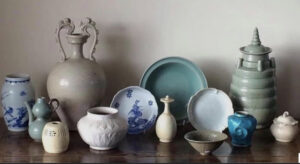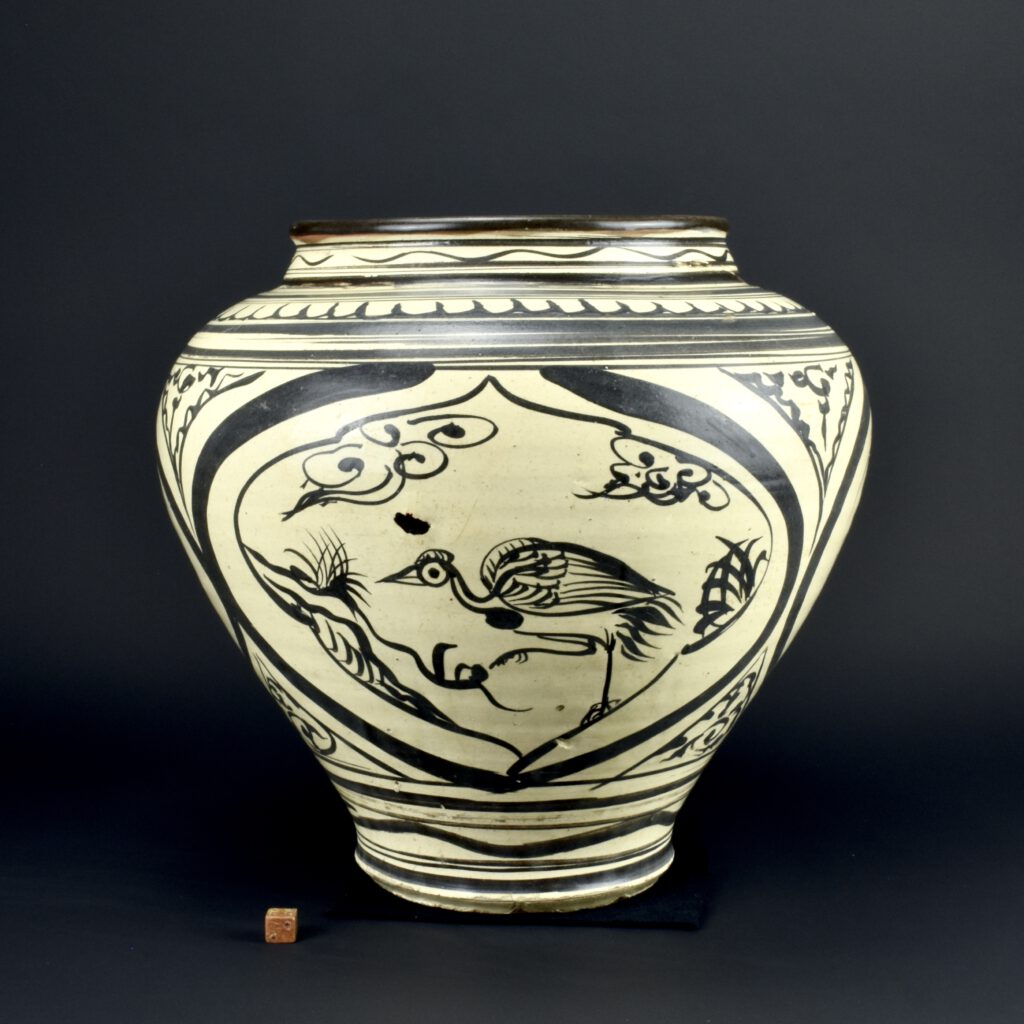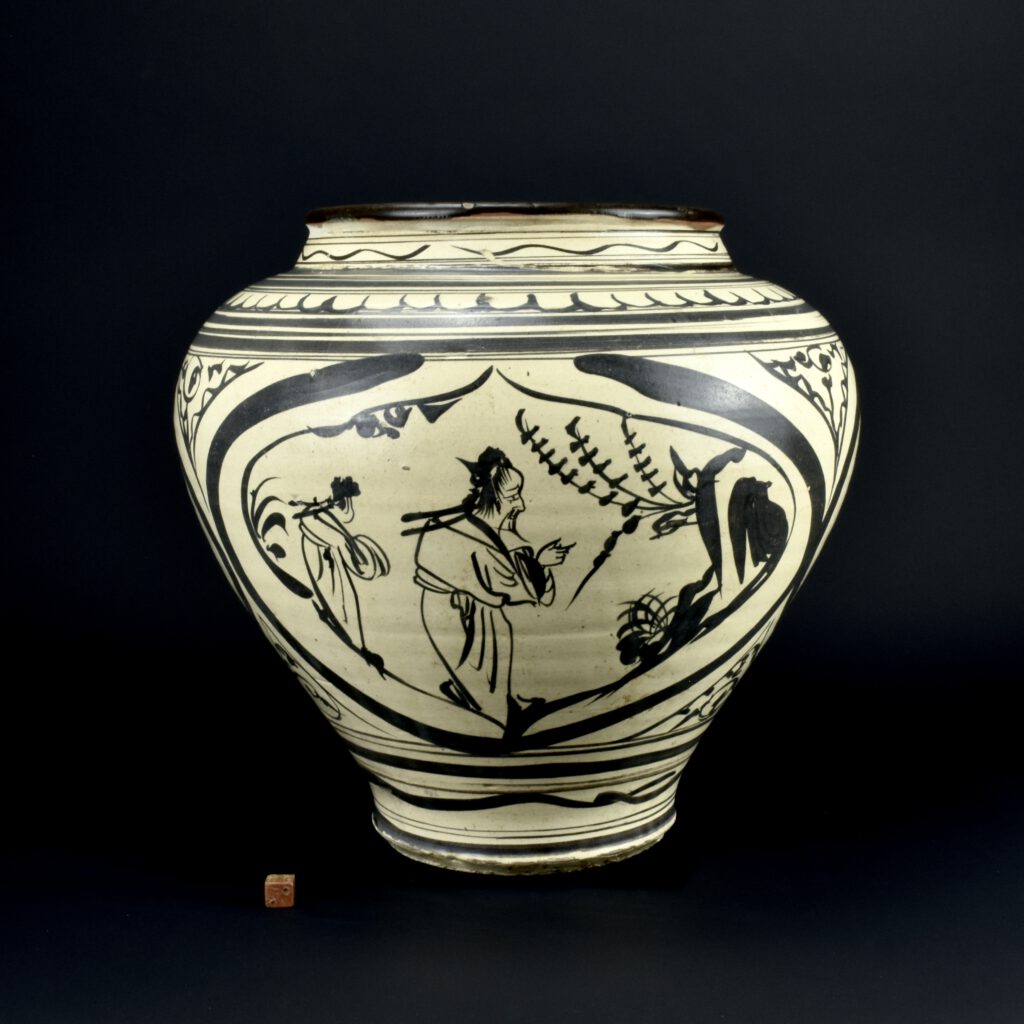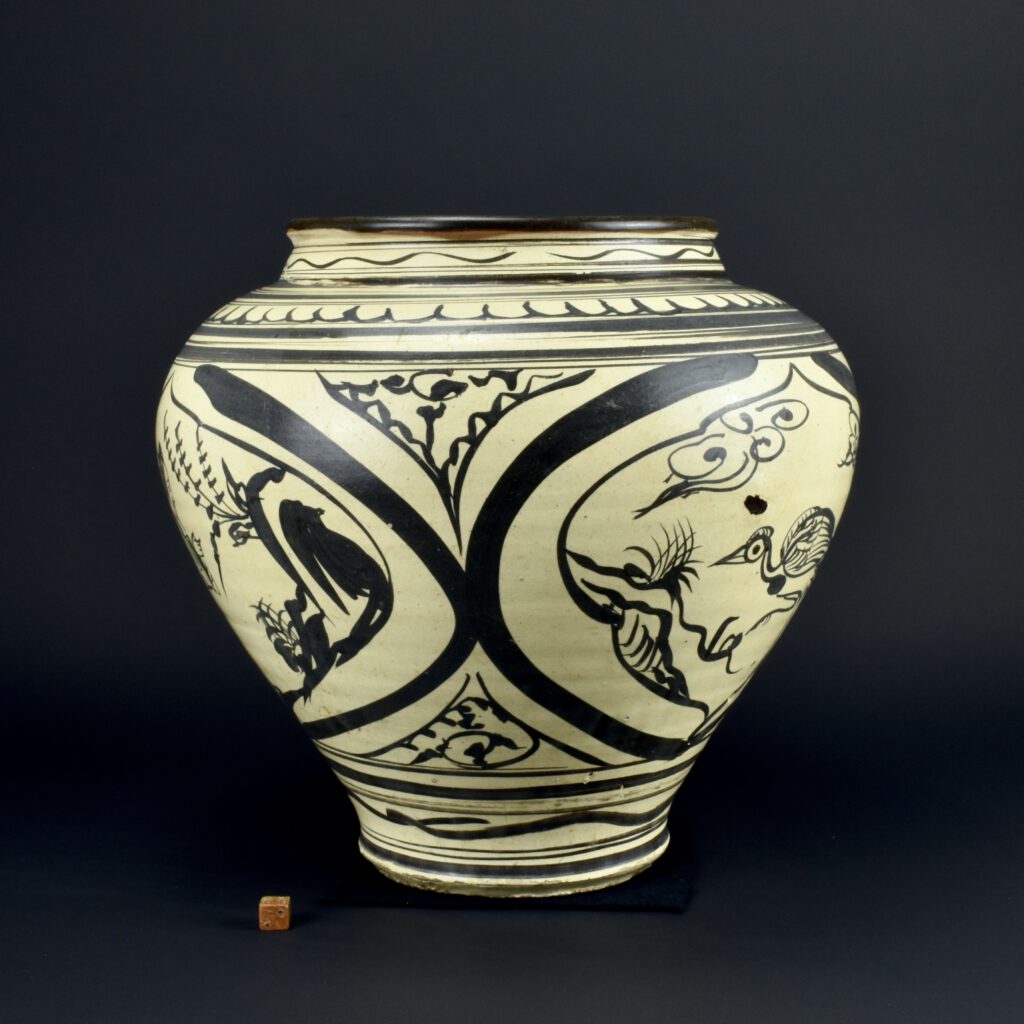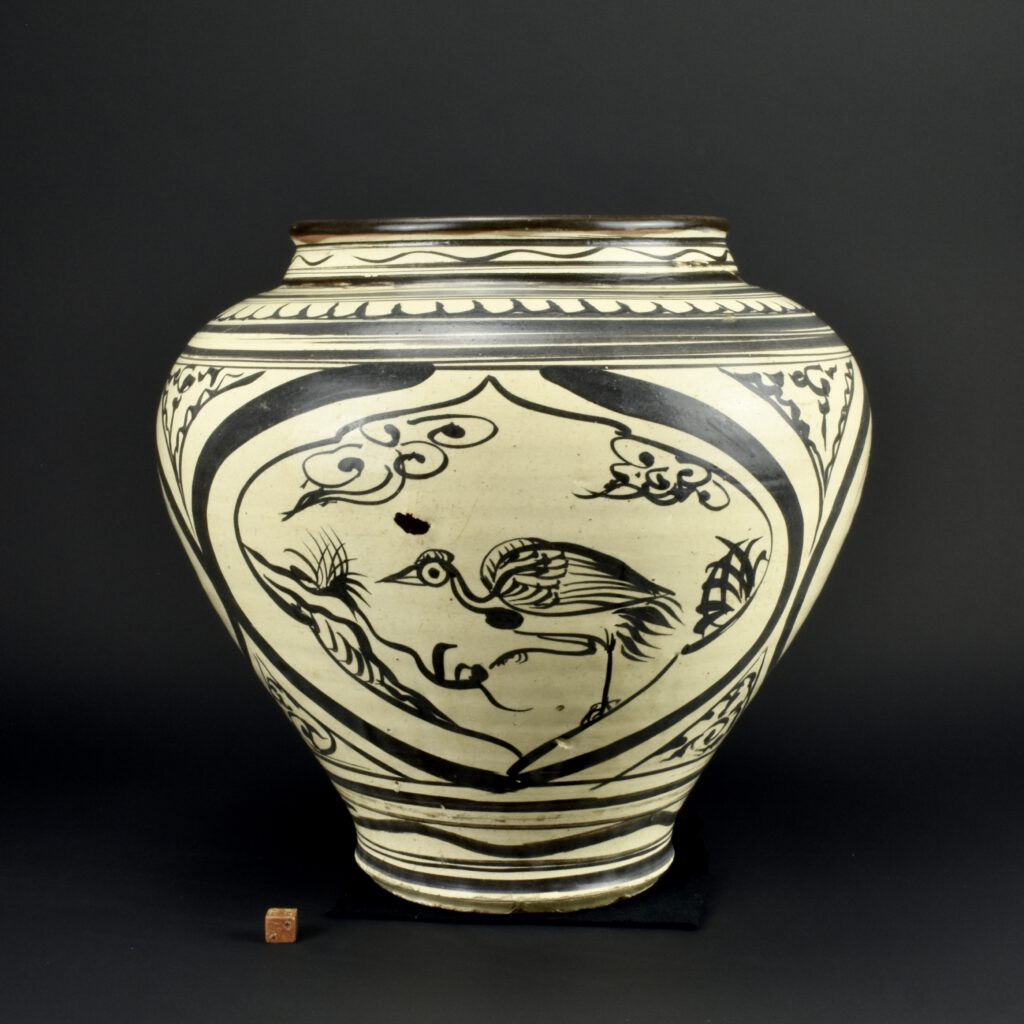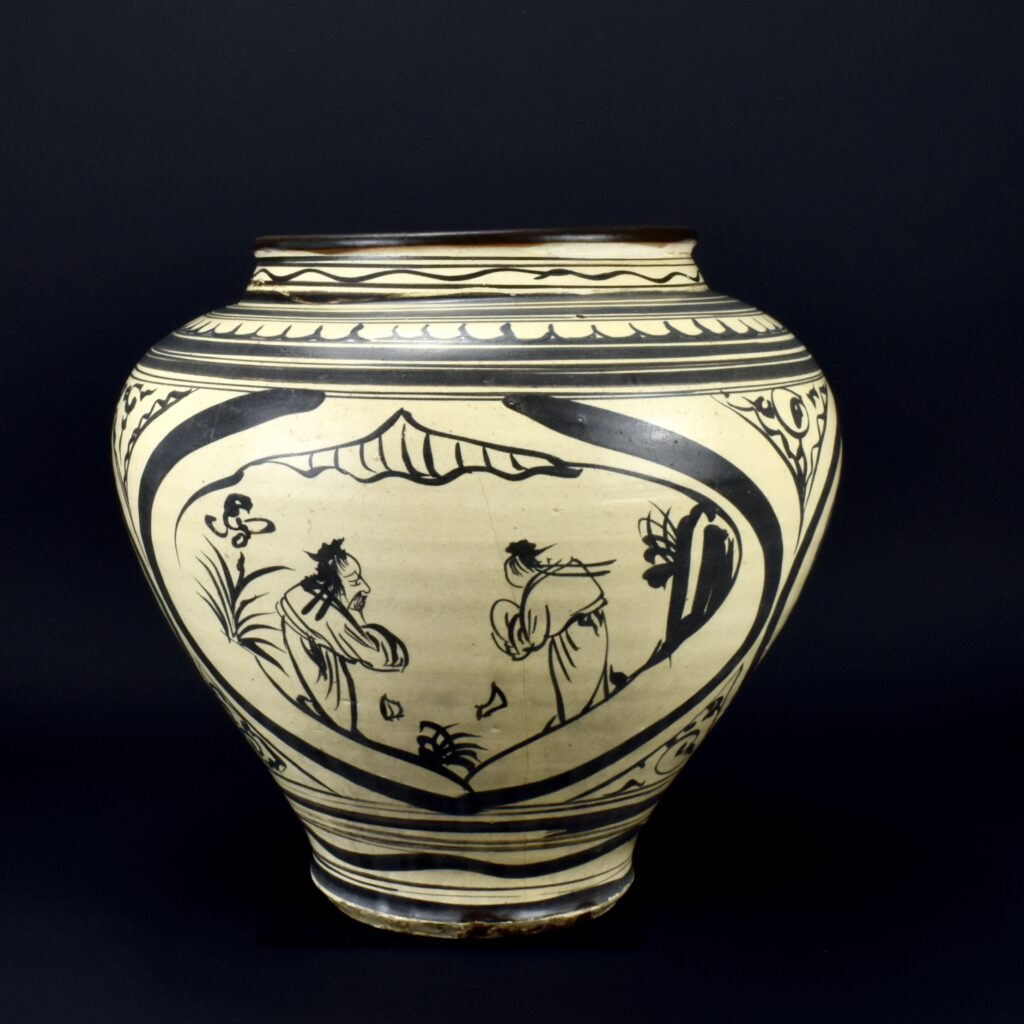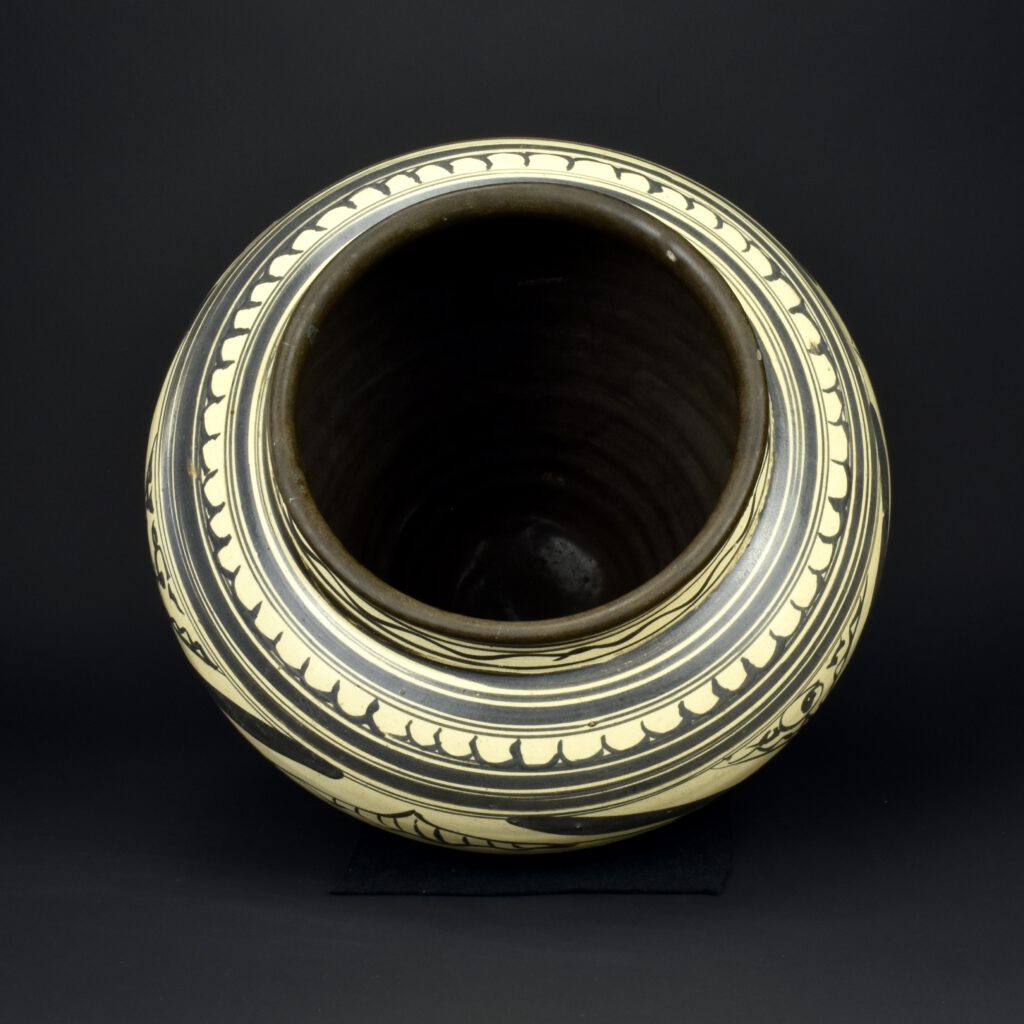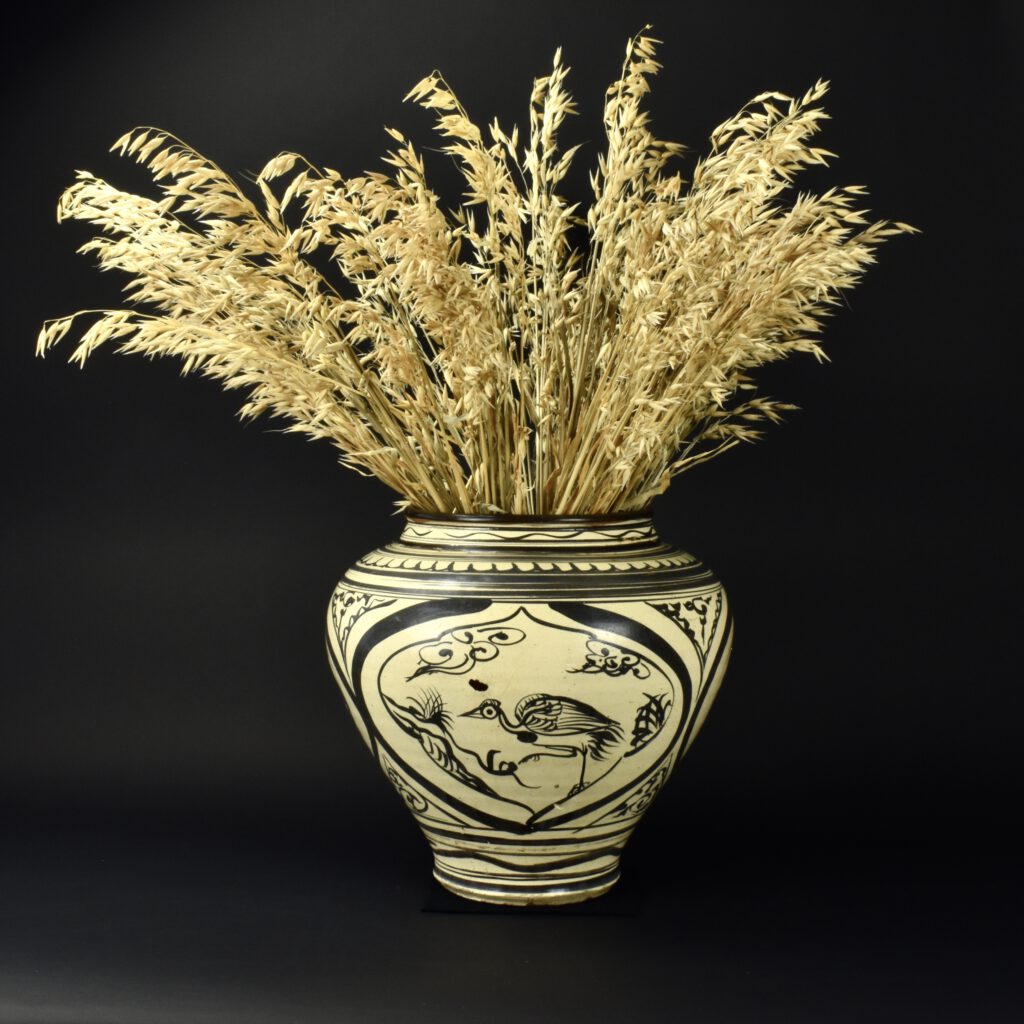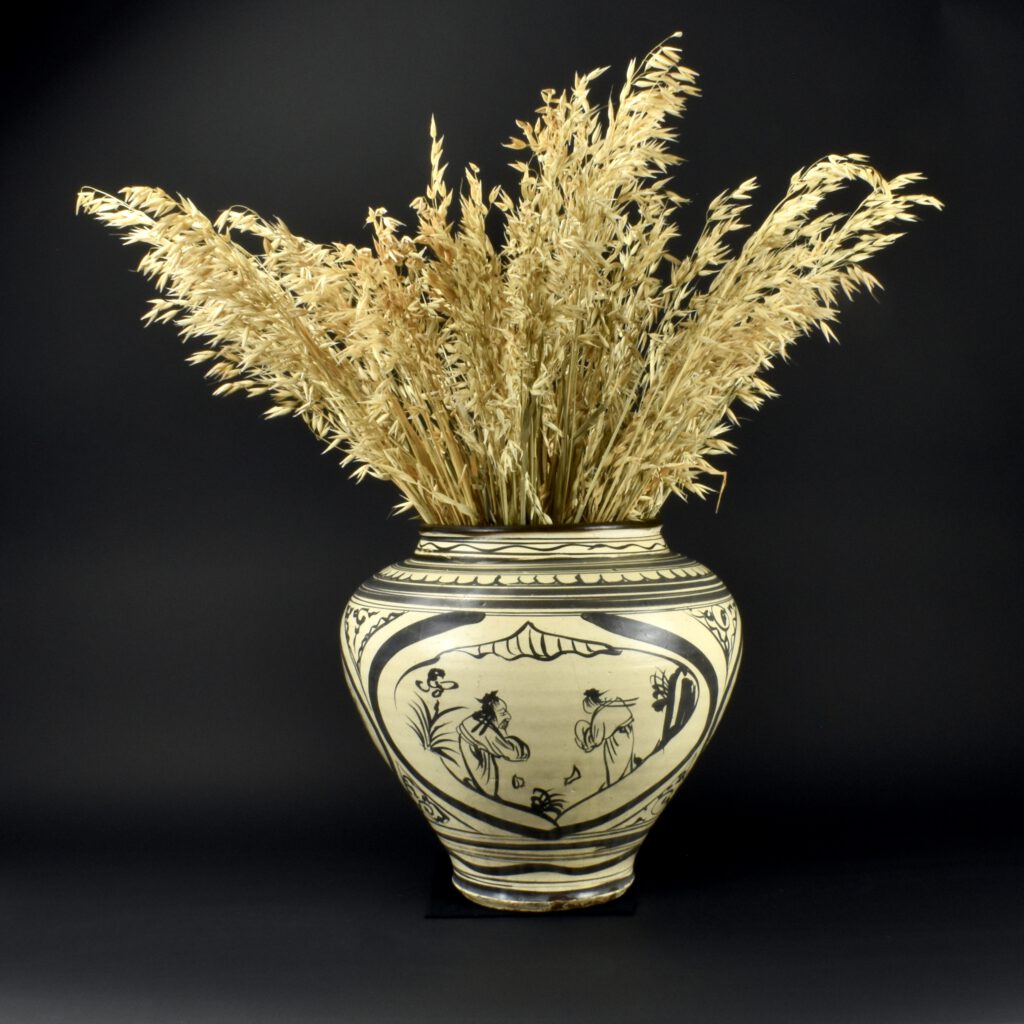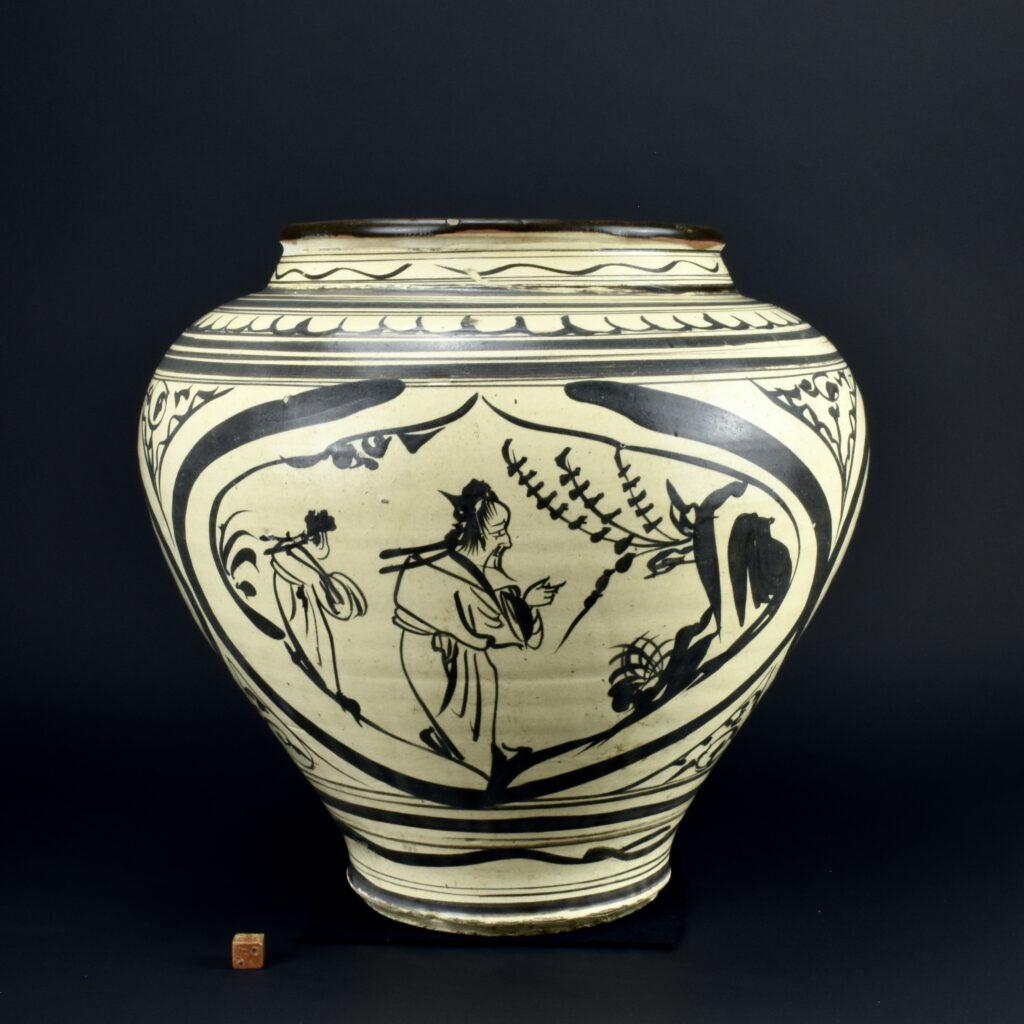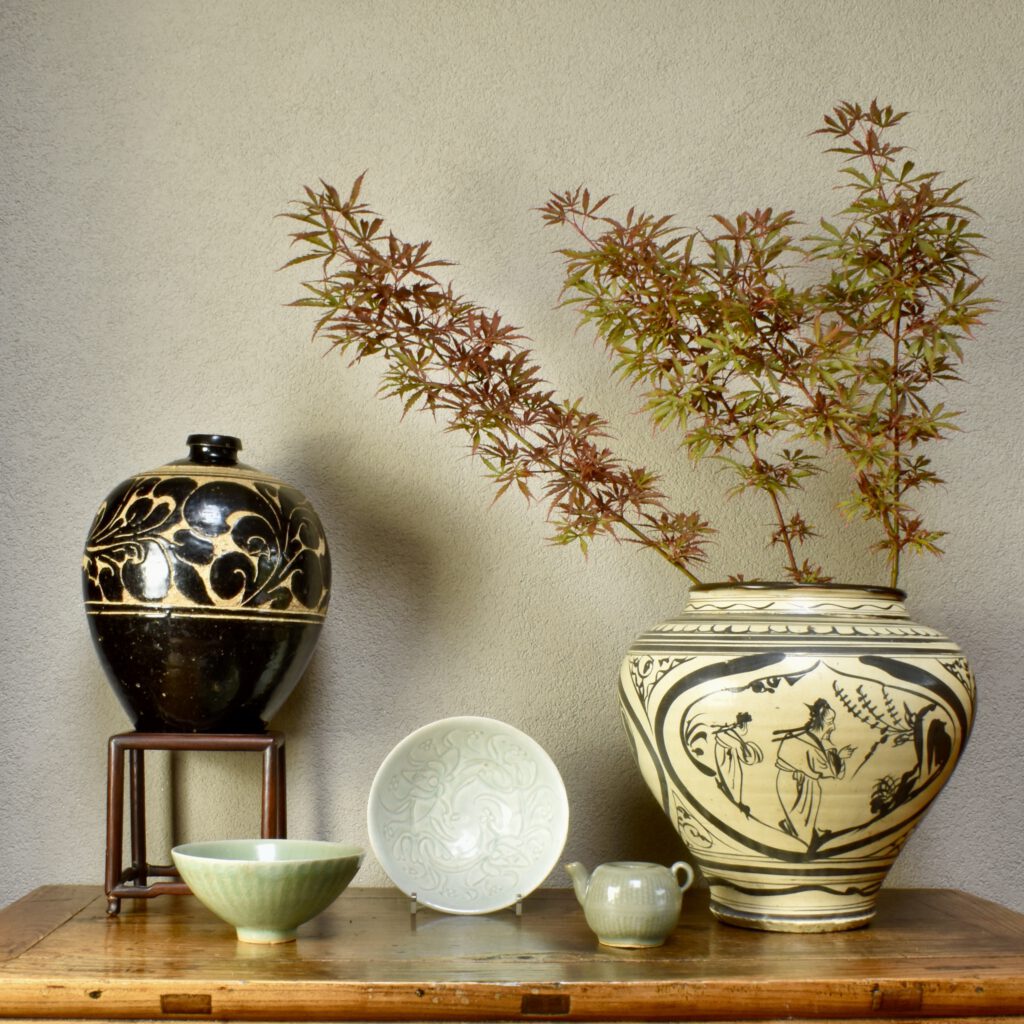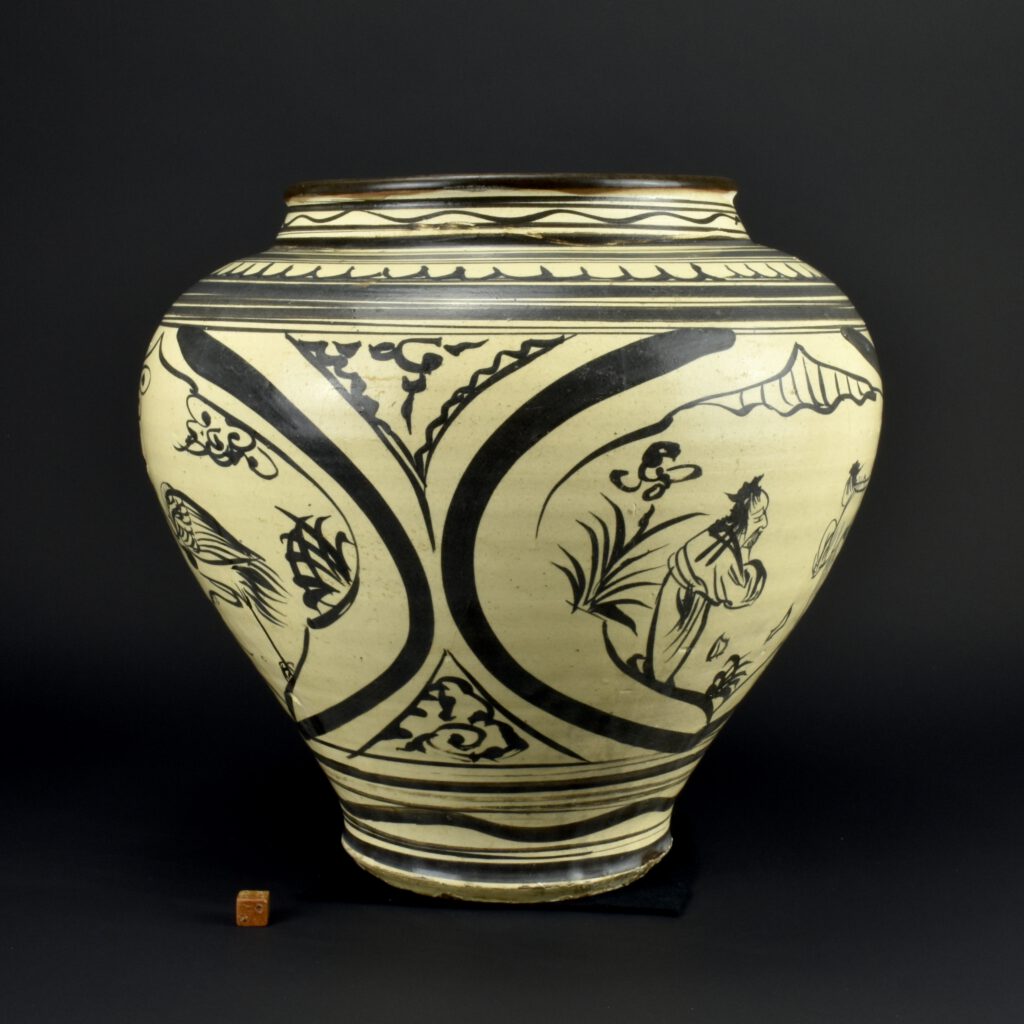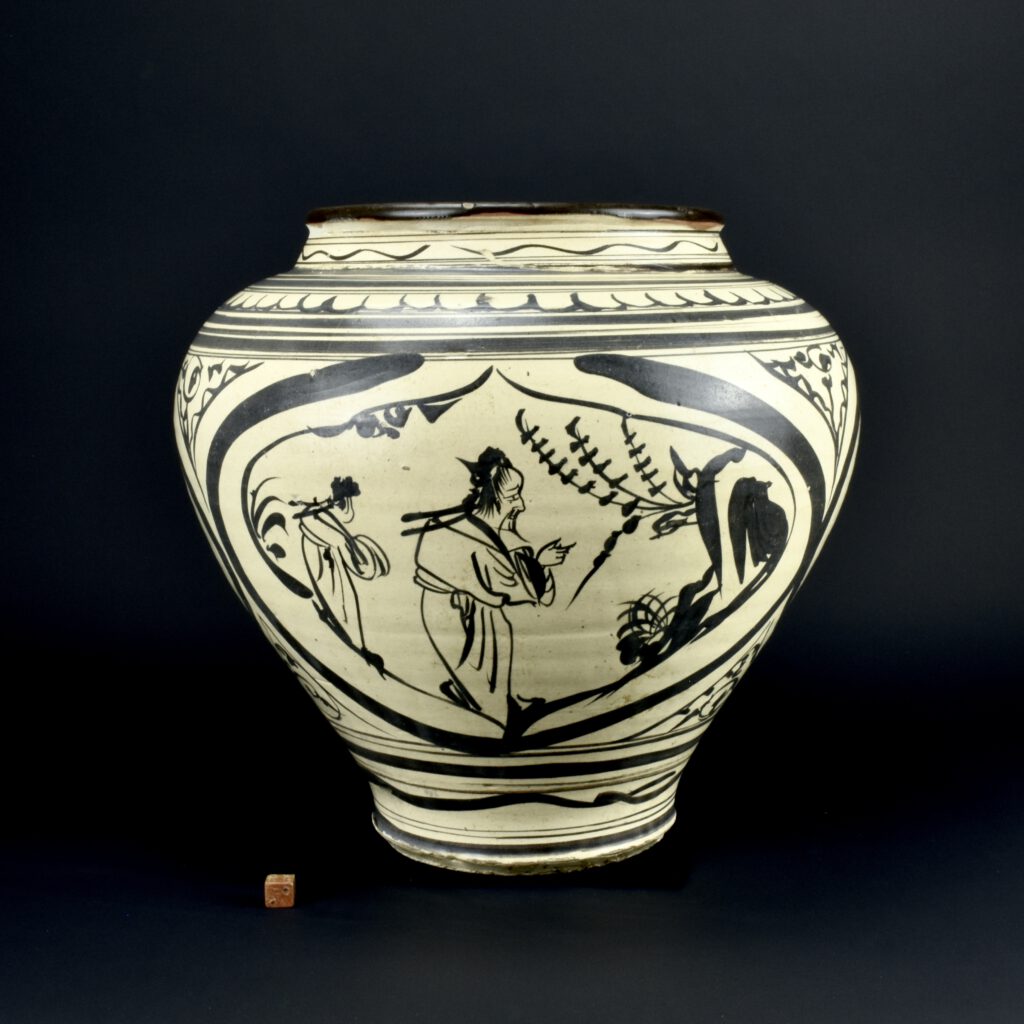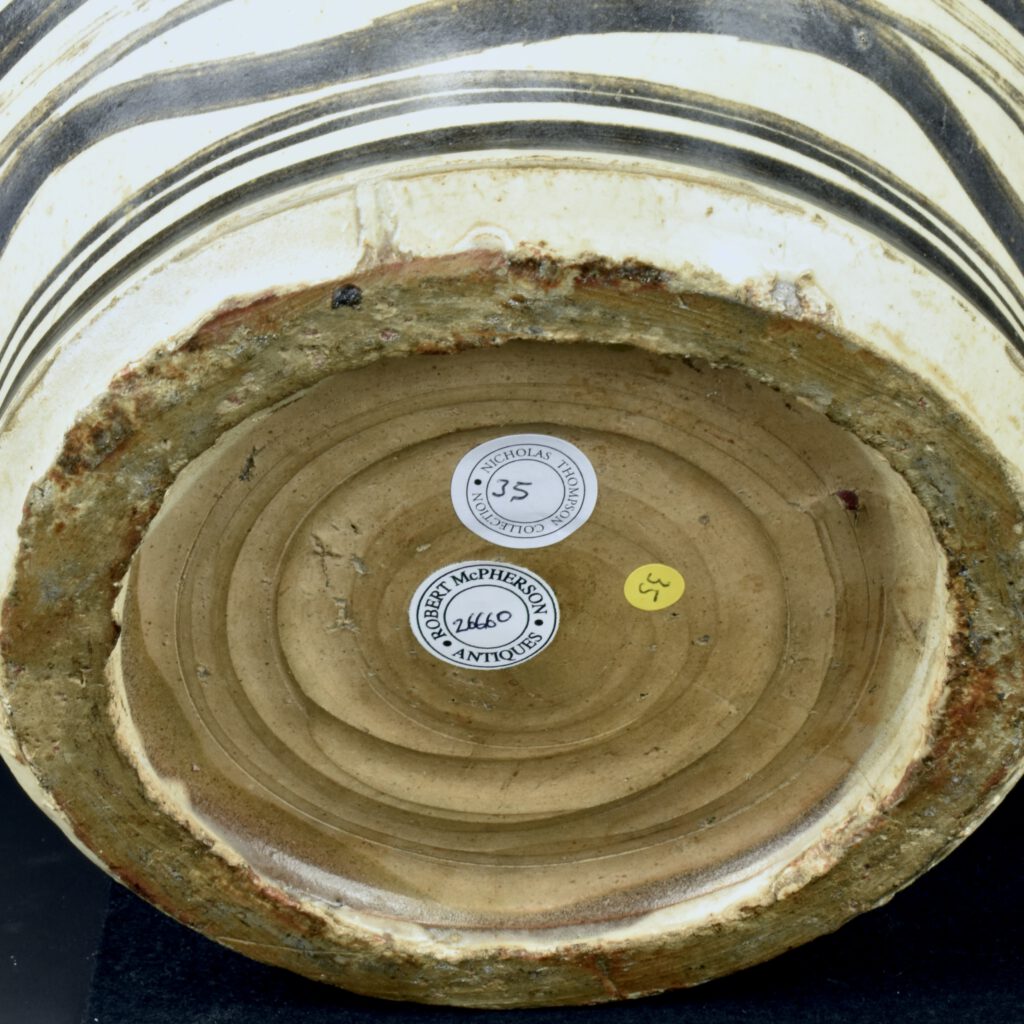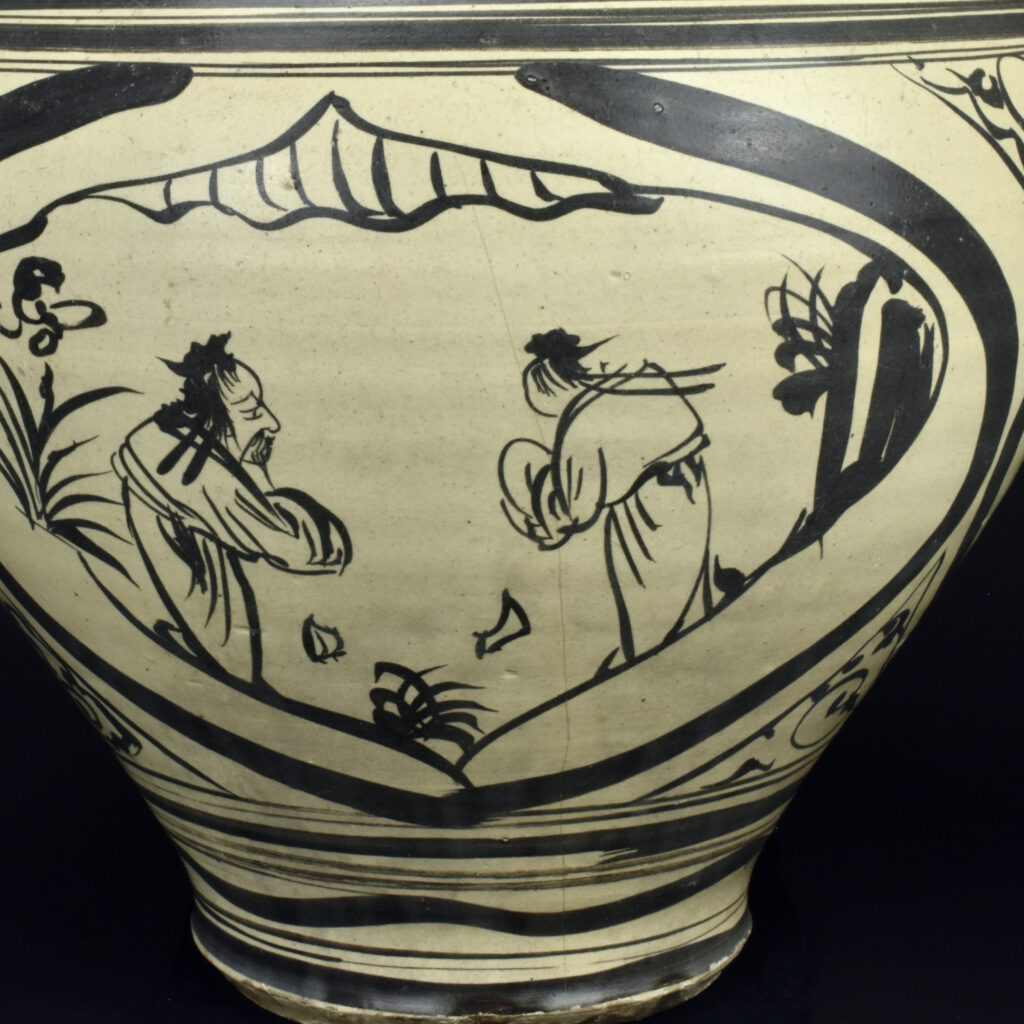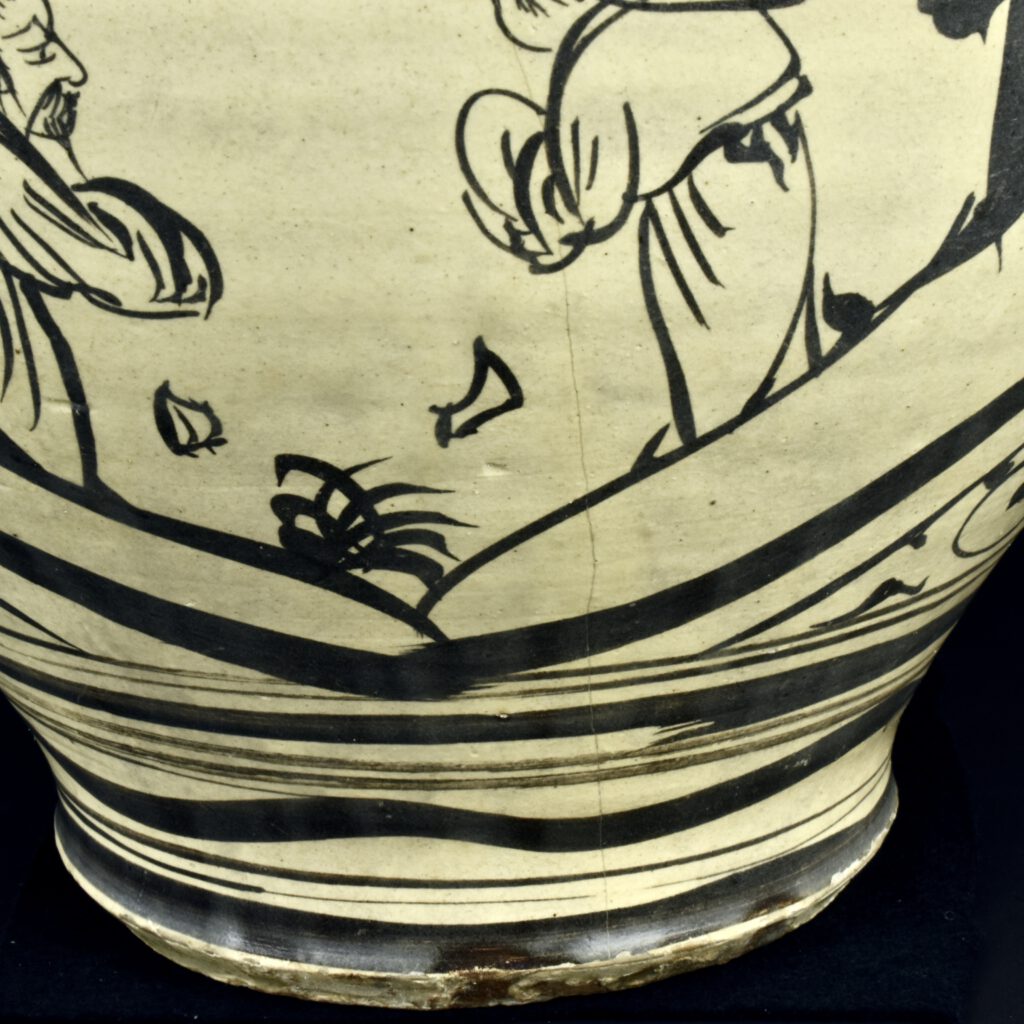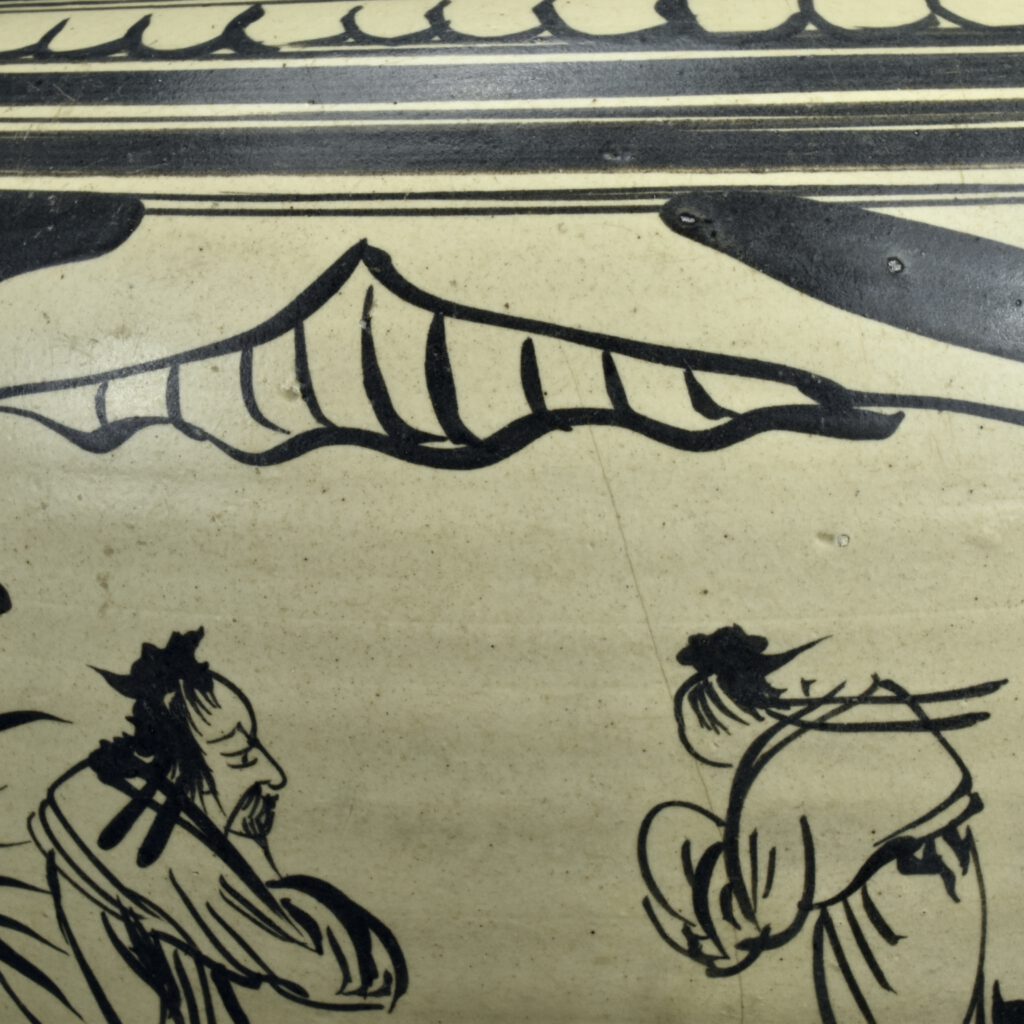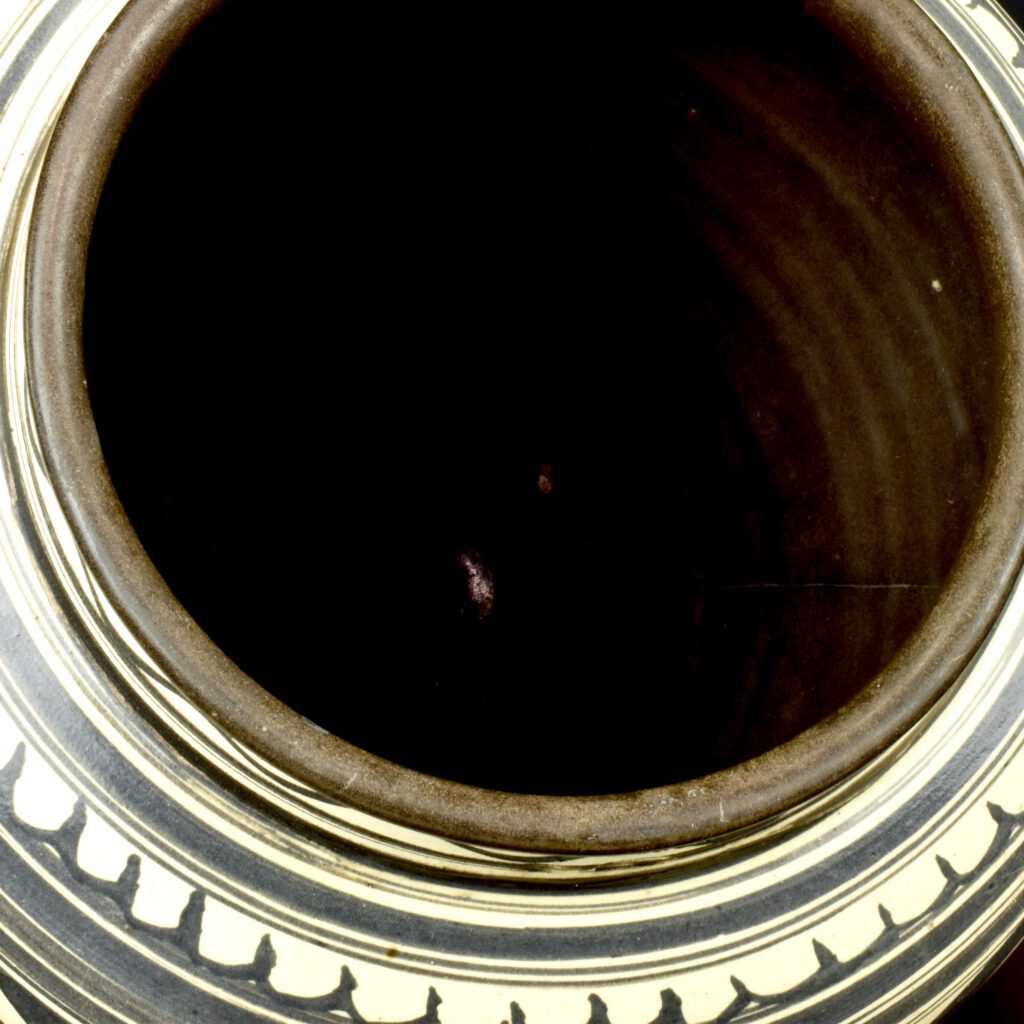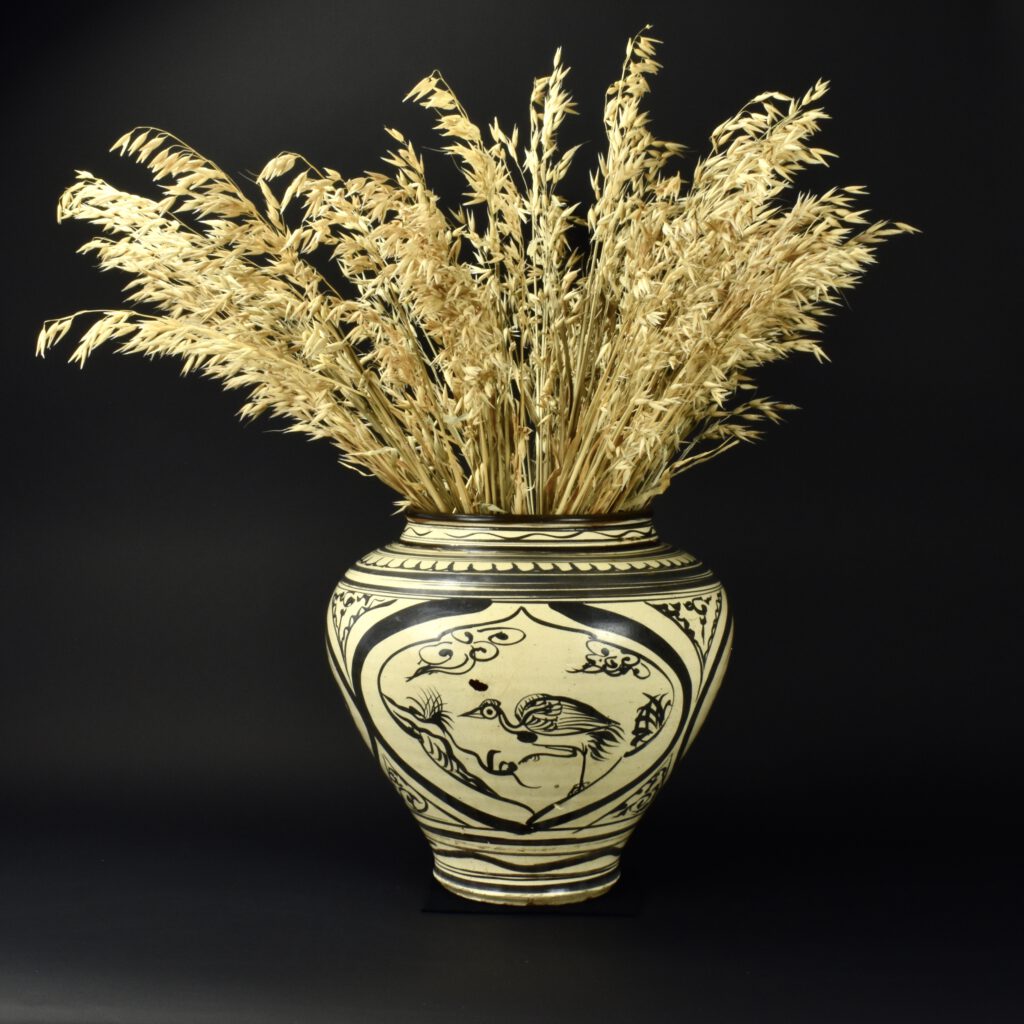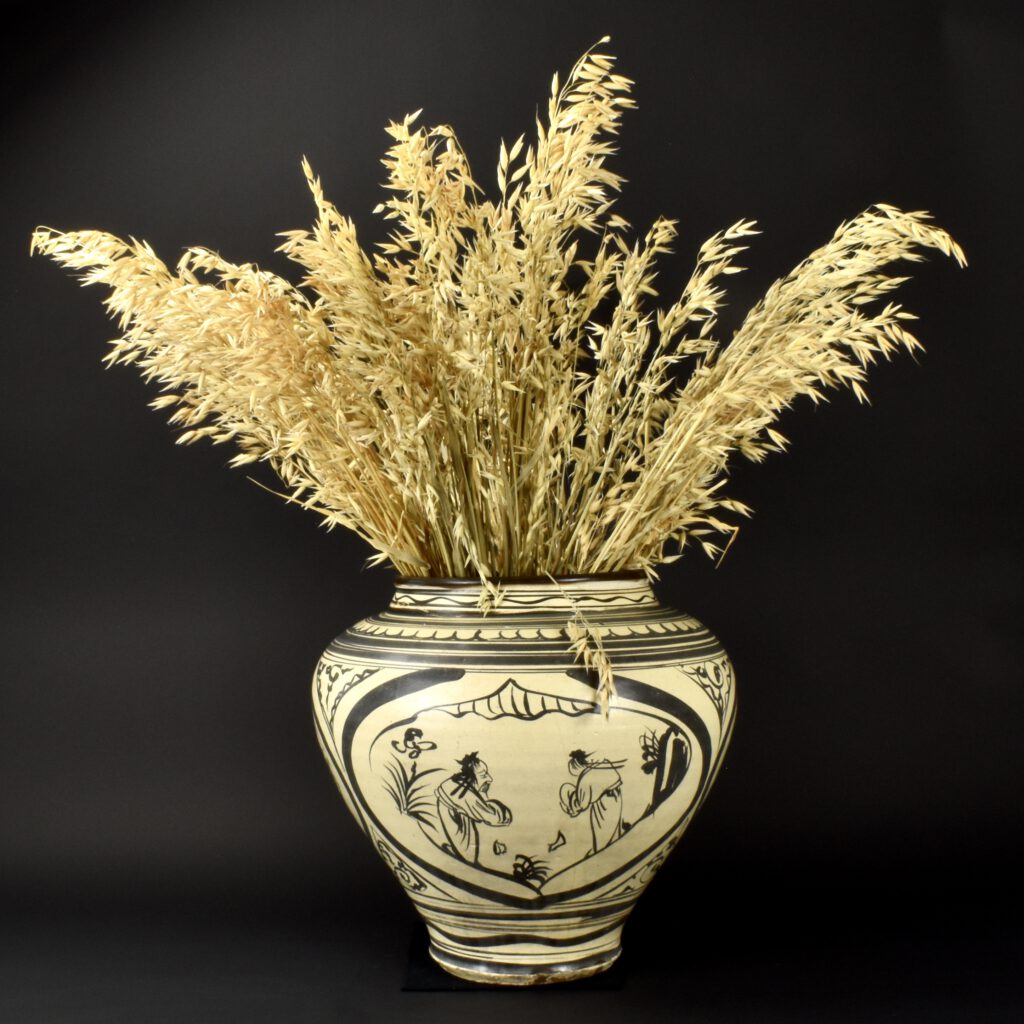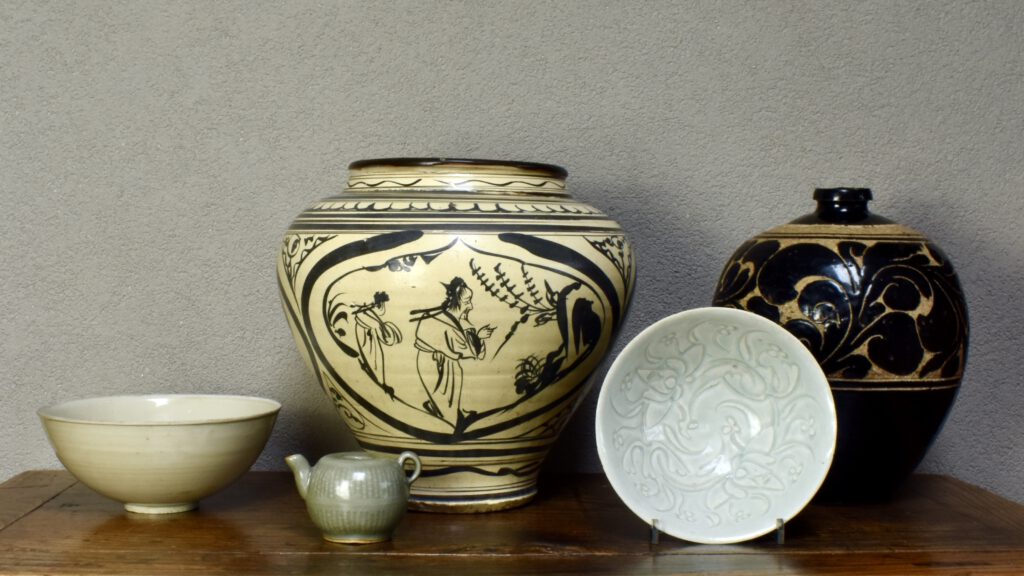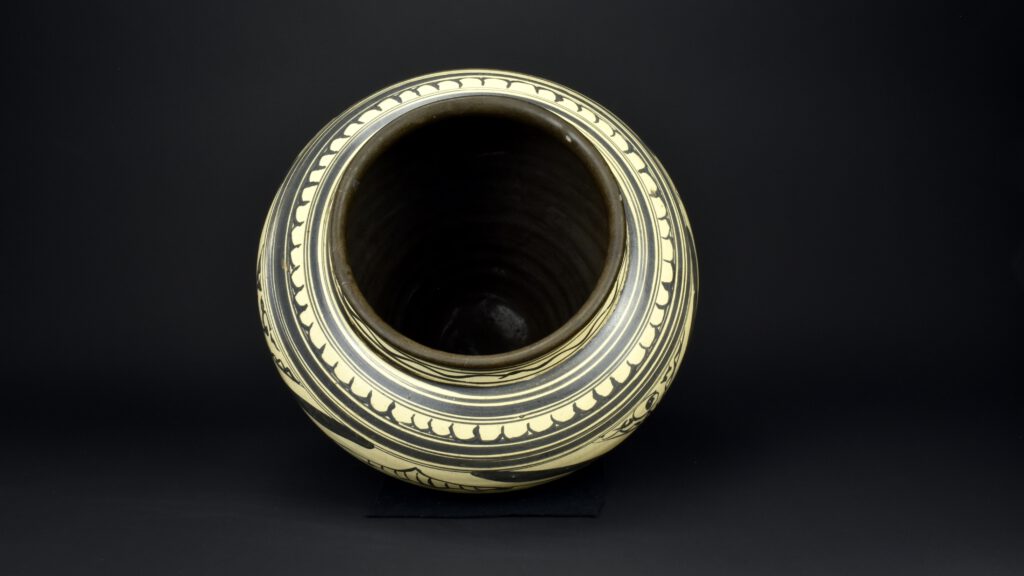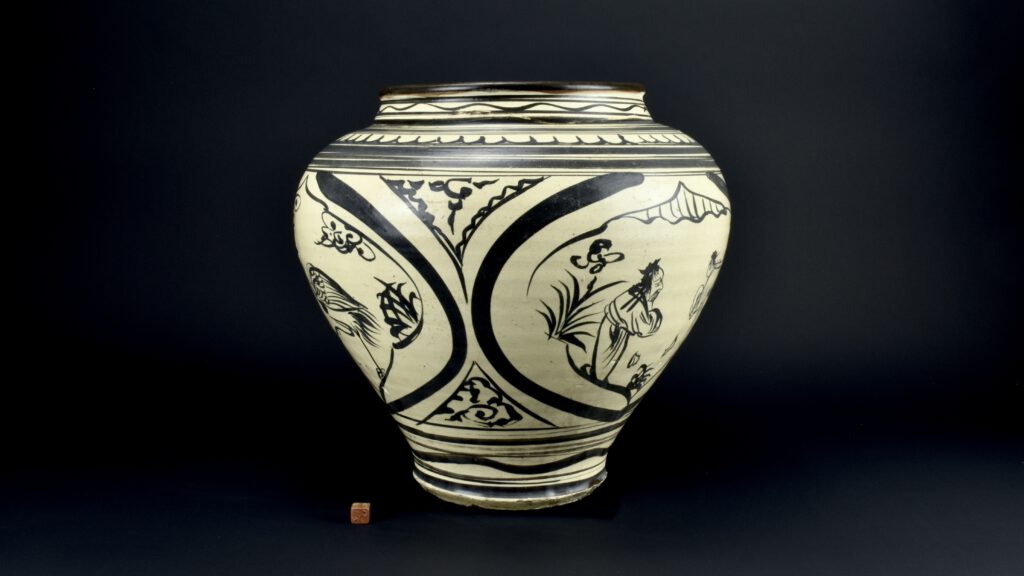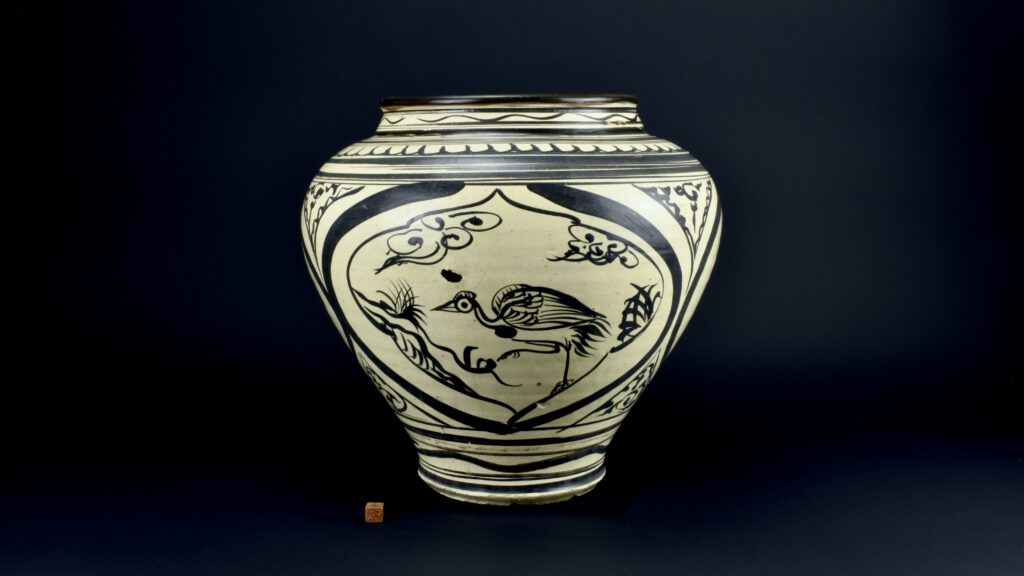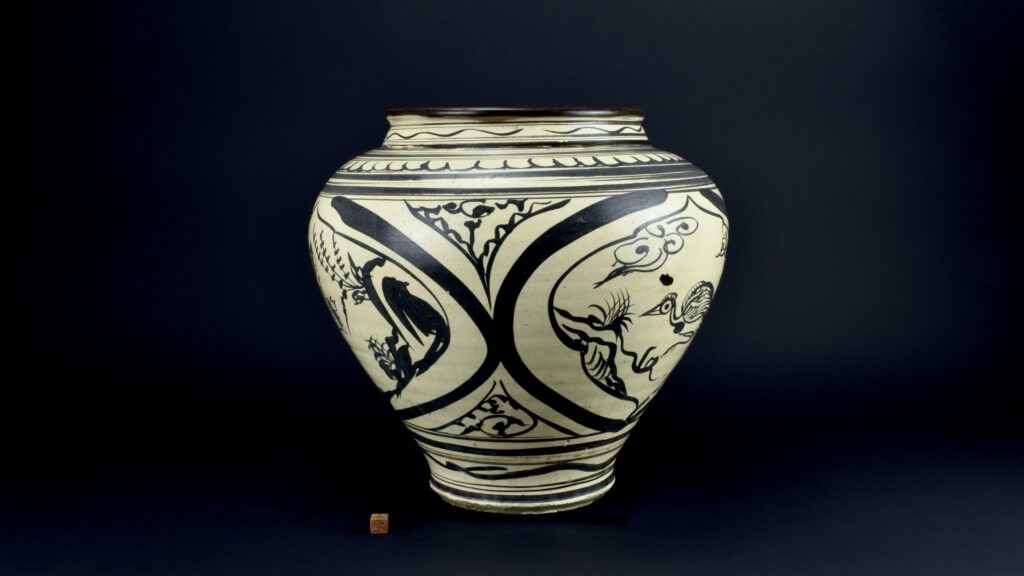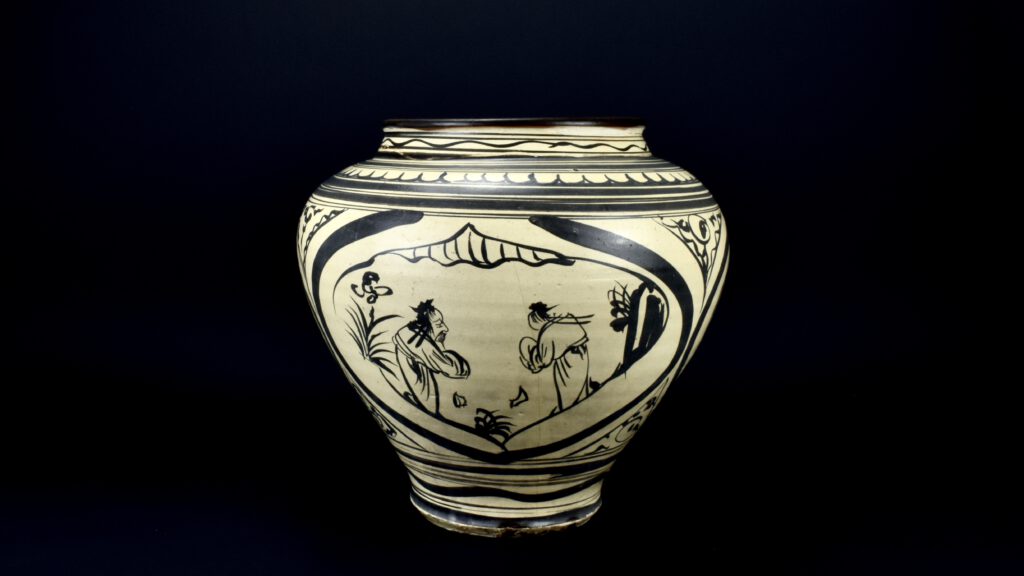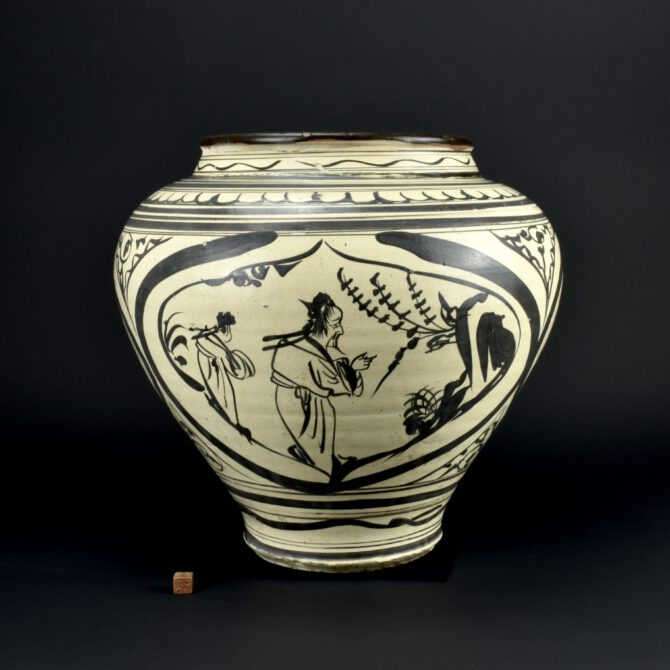
A Large Painted Cizhou Ware Guan, Yuan Dynasty
A Large Painted Cizhou Guan, Yuan or Early Ming Dynasty, 14th Century, North China. From Nicholas de la Mare Thompson (1928-2010). This large heavily potted guan, a wine jar from the collection of Nicholas Thompson, is made of stoneware covered with a cream-coloured slip. The painting is very similar to a well know Cizhou jar in the Metropolitan Museum of Art in New York, indeed, it seems likely the two jars were painted by the same person. Another very closely related jar, dated to the Yuan dynasty was sold at Christie’s New York, see ‘References’. The painting of the present jar is done at speed with great confidence, the broad borders and fine detail are all swiftly and skilfully. The three panels are made using single long strokes of a fully loaded brush, an elderly bearded scholar is walking along, he seems to be pointing, is diminutive assistant, follows close behind the senior person. The next panel depicts a scholarly man faces his assistant, who as in the other panel, hides his face. The third panel is of a stork, in China storks are symbols of longevity, wisdom and immortality. They are also associated with noble character, long-lasting love, and spiritual travel between heaven and earth. A Painted Yuan Cizhou Jar, very similar to the Present Example was sold for $68,750 (£50,000 at today’s rate) on March 17th, 2017, at Christie’s New York. See below the Photograph Gallery in ‘Information’ for a photograph of the Christie’s jar as well as other related Yuan Cizhou jars.
See Below For More Photographs and Information.
SOLD
- Condition
- There is a large crack from the base that extends from the base to high up on one panel, see detailed photographs in the Photograph Gallery below.
- Size
- Height 31 cm (12.2 inches). Top width 20 cm (7.8 inches).
- Provenance
- Sotheby's, Bond Street, London, 18th of December 1996. From the collection of my friend, Mr. Nicholas de la Mare Thompson (1928-2010). See below the 'Photograph Gallery' for more information.
- Stock number
- 26659
- References
- There are at least wwo Cizhou guan jars that have remarkably similar painting and were perhaps decorated by the same artist. One is in the Metropolitan Museum of Art in New York, is from the Robert Lehman Collection, 1975, object number 1975.1.1664. The other jar was sold at Christie's New York on March 17th 2017 (sold for $68,750 including premium). A third very stained jar of this type is in the Keramiek Museum Princessehof in Leeuwarden, see 'Information', below the 'Photograph Gallery'. A Very Rare Polychrome Cizhou Guan Art Institute Chicago, which they dated to the Ming dynasty.
Information
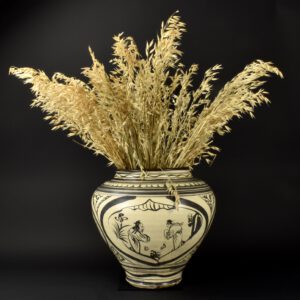
Cizhou Ware
The name Cizhou originated from the ancient area of Cizhou, encompassing a broad arc across China, which was first recorded during the Sui dynasty (581-618). However, the location constantly shifted and though the area of Cizhou is mentioned in the Tang dynasty (618-906) and Five Dynasties (906-960), each referred to an altered location. During the Song, Jin (1125-1234), Yuan (1279-1368), and partly into the Ming dynasties (1368-1644) the kiln areas of Cizhou were primarily concentrated in the northern provinces of Hebei, Henan, and Shaanxi.
The Metropolitan Museum of Art : Cizhou Guan
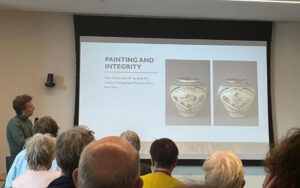
The Metropolitan Museum of Art : Cizhou Guan.
From the Metropolitan Museum of Art, New York.
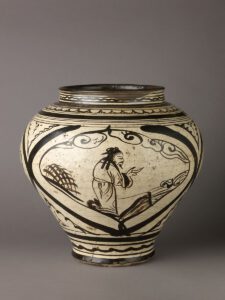
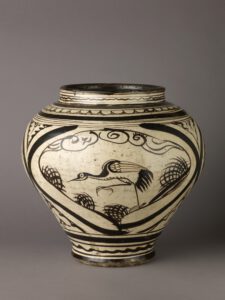
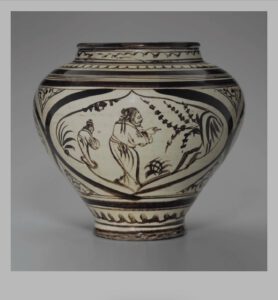
Another Yuan Cizhou Jar from this Group ; From the Avery Brundage Collection.
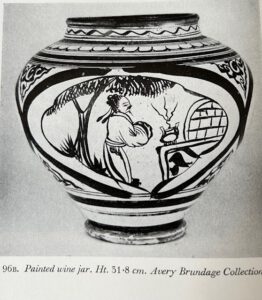
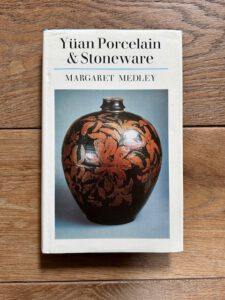
Another Cizhou Guan, in the Netherlands.
The Keramiek Museum Princessehof, Leeuwarden, dates their example to the early Ming dynasty c.1368-1400.
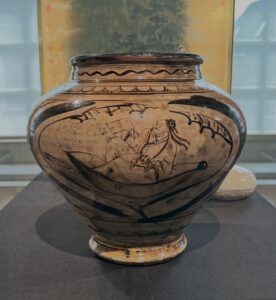
A Very Rare Polychrome Cizhou Guan Art Institute Chicago.
Dated to the Ming dynasty.
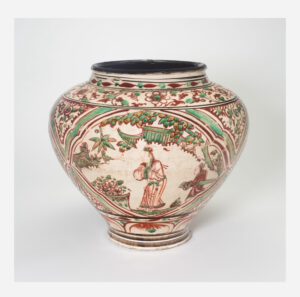
Nicholas de la Mare Thompson (1928-2010).

Nicholas de la Mare Thompson, the grandson of the author Walter de la Mare spent his career in publishing. He started at Nesbit where he was editor of the Janet and John series of children’s books but not all of his career was so safe. He wrestled with W.H. Smith over the content of Madonna’s raunchy Sex book on behalf of Paul Hamlyn’s Octopus Group and defeated Margaret Thatcher over Spycatcher. He could not bare dogma or hypocrisy.
It was hardly surprising that as a committee member of the O.C.S. he had his own ideas. He read and could recite great swaths of the articles of the Society, he used this not to attack but to stimulate debate. He approached the Society in the same way as he approached his understanding of Chinese ceramics, by stripping it down and starting again using clear empirical thinking. He was very concerned the Society was open to all and was run for the benefit of all members.
Nicholas came from a family of collectors, his love of oriental ceramics was broad but his focus was on early monochromes, especially those from the Song dynasty. He bought what he loved, what he thought had merit, not what was said to be good, and certainly not anything because it was fashionable. He didn’t have a stamp collectors’ approach, filling in the gaps of pre-existing ordered collection, rather he would react to an object, feeling it was right for his collection. Sometimes he wasn’t sure if it was right for his collection or not. He would then “borrow” pieces and live with them, other times he would ask his wife Caroline, who’s eye he trusted, if he should keep the piece or not. He was amused because I was often able to know if he would keep a piece before he did. We discussed “pots” endlessly, he loved to talk about ceramics with a wide variety of people and enjoyed the company of others on O.C.S. trips as well as in discussion groups or anywhere else. Later on he combined his love of Chinese ceramics with his love of books by extending his library to include rare early books, he used these to trace the development of collecting and scholarship in the 19th and early 20th century. He was fascinated by earlier scholarship, what was not understood but also what they understood, and we have lost. He was always reading and wanted to know more right up to the end, he didn’t see impending death as a barrier to knowledge or indeed collecting. The week before he died he questioned, if only for a second, whether it was too late to buy another pot for the collection. He concluded it was not, he was a true collector.
Nicolas died on the 25th of April 2010 at the age of 82 after living with cancer for two years. He leaves behind his energetically supportive wife Caroline and his three children. He was a kind, gentle and incredibly civilised man with a very sharp mind and dry sense of humour, he was passionate about the Society, its aims and its members. He was an incredibly supportive and thoughtful friend and will be missed very much.
